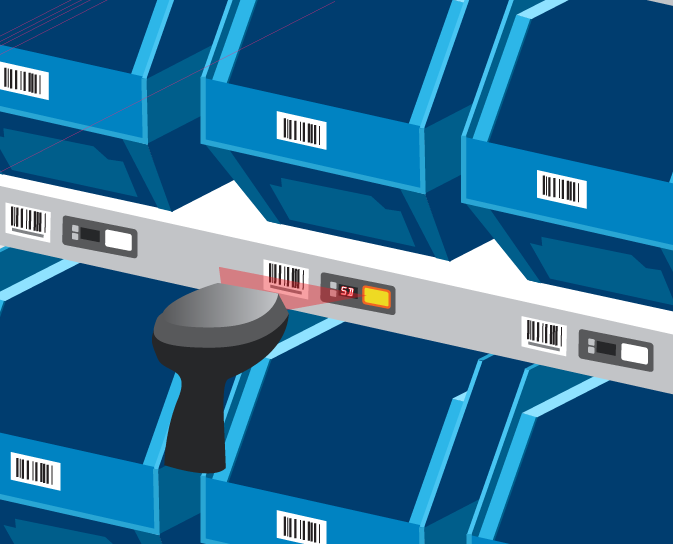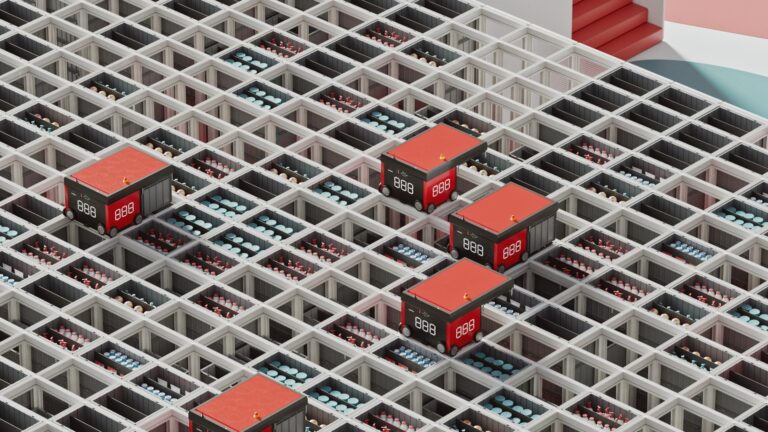Key Performance Indicators, or KPIs, are measurable and quantifiable metrics used to evaluate the performance and effectiveness of a business, department, or specific process. They provide organizations with valuable insights into their operations, helping them track progress, make informed decisions, and achieve their strategic goals.
With the competitive nature of modern supply chains, there is an undeniable need for data-driven decision-making. In warehouse management, KPIs are here to provide the information for these decisions. They play a crucial role in monitoring and optimizing various aspects of warehouse operations including Inventory Management, Order Fulfillment, Labor Productivity, Warehouse Capacity and Utilization, and Supply Chain Visibility.
Inventory Management KPIs
Inventory management KPIs are instrumental when you are looking to maintain optimal stock levels, minimize business costs, and ensure the accuracy of stock data. Two specific KPIs in this realm to focus on are inventory turnover rates and stock accuracy.
Inventory Turnover Rate
This KPI measures how quickly a company’s inventory is sold and replenished over a specific period of time, usually on a yearly basis. A high turnover rate indicates efficient inventory management, as it means that products can effectively and quickly move through the supply chain. Additionally, it means that the stock levels are being managed effectively, that carrying costs are reduced, as well as preventing overstocking and understocking choke points.
To calculate this KPI, you need to divide the Cost of Goods Sold (COGS) by the average inventory value. It is crucial for cash flow management and optimizing the allocation of resources within the warehouse.
Stock Accuracy
Stock accuracy KPIs, such as the percentage of accurate stock counts or cycle counting accuracy, measure the precision of the inventory data compared to the actual physical inventory. When a business has an accurate understanding of what is in their inventory, they can reduce the risk of stockouts, over-ordering, and other costly errors.
Warehouses are enabled to identify discrepancies early on, well before a bottleneck occurs, and take corrective actions and improve the overall operational efficiency of the distribution center.

Order Fulfillment KPIs
Order fulfillment KPIs, like order cycle time and perfect order rates, are essential for evaluating the efficiency and quality of a company’s order processing and delivery processes. They are responsible for ensuring timely and accurate delivery to customers.
Order Cycle Time
Order cycle time is how businesses measure the duration it takes to process an order from the moment it is received until the moment it is delivered to the customer. This specific KPI is critical when a business is looking to assess the speed and general responsiveness of their order fulfillment process.
Shorter cycle times are indicative of a more efficient and agile operation, which almost certainly leads to higher customer satisfaction and increased competitiveness in the market. By monitoring and optimizing order cycle time, your business can identify bottlenecks in your supply chain and streamline processes.
This is a factor you will want to pay attention to if one of your primary goals is to reduce lead times and improve your delivery speed.
Perfect Order Rate
The perfect order rate is the measurement that calculates the percentage of orders that are delivered to customers without any errors or issues. When discovering this KPI, companies will want to take factors like order accuracy, on-time delivery, and the completeness of the order into account.
A high perfect order rate indicates that the company consistently meets customer expectations and minimizes disruptions in the order fulfillment process. Achieving this feat is a key goal for businesses, as it leads to increased customer loyalty, reduced return rates, and a positive reputation in the market.
To improve the perfect order rate KPI, companies should focus on enhancing order accuracy, inventory management, and logistics coordination.

Labor Productivity KPIs
When a business is thinking of evaluating the efficiency and effectiveness of their workforce, they will want to investigate Labor Productivity KPIs. These key performance indicators are essential in the general assessment of workforce performance within a warehouse setting and, when they are properly tracked, can help save money, increase operational efficiency, and lead to an overall productivity boost.
Pick and Pack Efficiency
This KPI measures the speed and accuracy of the picking and packing process within a warehouse. When calculating your warehouses pick and pack efficiency, you will divide the number of items picked and packed by the total labor hours spent on the tasks.
High pick and pack efficiency indicates that workers are performing their tasks quickly and accurately, while also minimizing order processing times and reducing the risk of errors. By monitoring and analyzing pick and pack efficiency, warehouse managers can identify areas for improvement, sections that are prone to bottlenecking, and where the incorporation of automation technologies can increase efficiencies.
Optimizing this KPI will eventually lead to significant cost savings, improved order fulfillment speed, and enhanced customer satisfaction. When orders are properly processed in a timely manner, the entire operation will see an increase!

Labor Utilization
Labor Utilization KPI measures how effectively the workforce is deployed within your warehouse. It considers factors such as the ratio of productive work hours to total work hours, the balance between labor supply and demand, and the avoidance of idle time.
High labor utilization means that employees are consistently engaged in productive tasks, maximizing their contributions to the warehouse’s operations. Efficient labor utilization can lead to reduced labor costs and increased throughput.
If you are looking to improve this specific KPI you should consider utilizing workforce management systems to schedule shifts and allocate your labor resources based on demand fluctuations and workload variations.
Warehouse Capacity and Utilization KPIs
Dock Turnaround Time
Dock turnaround time is a critical KPI that measures the time it takes for a vehicle to enter your warehouse’s loading dock, complete its loading or unloading process, and then exit the facility. If your business has a chokepoint at the inbounding or outbounding section of its logistics operations, then this KPI will need to be properly assessed.
By shortening dock turnaround times, your business can expect to see significantly faster throughput, reduced congestion, and an improvement in resource allocation. Efficiency in this KPI is also vital for meeting customer demand, minimizing transportation costs, and guaranteeing timely product deliveries.
Warehouse managers should focus on streamlining the receiving and shipping process, as well as optimizing the scheduling and coordination of vehicles if they are looking to reduce dock turnaround times.

Storage Space Utilization
Storage space utilization measures how efficiently the available storage space within a warehouse is utilized. When calculating this KPI, which is most often expressed as a percentage, you will want to divide the actual occupied storage space by the total available storage space.
High storage space utilization indicates that the warehouse is maximizing its available resources and minimizing waste space. If your business is looking for ways to reduce overhead costs often associated with excess storage capacity and ensuring that products are stored in the easiest method for quick access and retrieval, then maximizing this KPI is the way to go.
By regularly monitoring storage space utilization, you can identify opportunities for reorganizing layouts, implementing better storage strategies, and optimizing inventory management to make the best use of their available space.
Secure Your Competitive Edge with AutoStore
THE WORLD’S FIRST AND LARGEST AUTOSTORE DISTRIBUTOR
Supply Chain Visibility KPIs
Supply chain visibility KPIs are essential for tracking and improving the performance of the entire supply chain. They ensure that products are delivered on time and that variability in lead times is kept to a minimum.
On-Time Delivery
On-time delivery is straightforward in its definition. It measures the percentage of shipments or orders that are delivered to customers or receiving locations according to the agreed-upon delivery schedule. It is a critical KPI for assessing the reliability and efficiency of a supply chain.
High on-time delivery rates on time indicate that the supply chain is consistently meeting customer expectations and demand forecasts. Achieving and maintaining a high on-time delivery rate is essential for customer satisfaction, as late deliveries can lead to increased costs, stockouts, and potential loss of business.
It is pivotal that suppliers, manufacturers, logistics providers, and others involved in the supply chain must collaborate effectively to ensure that products are delivered punctually.

Lead Time Variability
Lead time variability measures the consistency or variation in the time it takes for goods to move through the supply chain, from order placement to receipt. The KPI is usually expressed as a standard deviation or coefficient of variation
Reducing lead time variability is essential for improving supply chain predictability and efficiency. This is because consistent lead times enable better demand forecasting, inventory management, and production planning.
A lower lead time variability KPI is a good indicator that the supply chain operates with greater stability and reliability, reducing the need for excessive safety stock and enhancing overall responsiveness to market changes.
Conclusion
The world of warehousing and supply chain management is constantly evolving, and businesses need to stay ahead of the times by continuously monitoring and improving their key performance indicators. These metrics are not just simply numbers, they are the compass that can guide your warehouse operations towards efficiency, cost-effectiveness, and customer satisfaction! If you can harness the power of KPI’s, you may gain valuable insights into their processes, gain the ability to quickly identify areas for improvement, make informed decisions, and ultimately optimize your entire supply chain.
At SDI Element Logic, we understand the critical role that KPIs play in warehouse management. We specialize in providing cutting-edge solutions designed to help you achieve and surpass your warehouse performance goals. From enhancing storage space utilization and labor productivity to improving order fulfillment and supply chain visibility, our innovative technologies and expert guidance are tailored to address your unique challenges.
If you are looking to take your warehouse operations to the next level and unlock greater efficiencies and profitability, you should act today.
SDI Element Logic is a reliable partner with the experience needed to help you embark on a journey toward optimization to make sure that your business remains competitive and poised for success!


